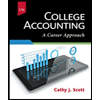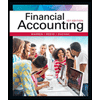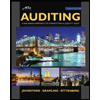
FINANCIAL & MANAGERIAL ACCOUNTING
9th Edition
ISBN: 9781266265549
Author: Wild
Publisher: MCG
expand_more
expand_more
format_list_bulleted
Question
Chapter 3, Problem 26E
a.
To determine
Introduction:
To compute: The current ratio of the company.
b.
To determine
Introduction: Instruments that have a maturity period of less than one year are known as short-term obligations. It is recorded under current liabilities in the
The company that pays short-term obligations faster.
Expert Solution & Answer
Want to see the full answer?
Check out a sample textbook solution
Students have asked these similar questions
Step by step.....?
Please help!!!! I need it bad
A company sells a product for $25 per unit. The variable cost per unit is $15, and the total fixed costs are $50,000.
a) How many units must the company sell to break even?
b) If the company wants a profit of $10,000, how many units must it sell?
Chapter 3 Solutions
FINANCIAL & MANAGERIAL ACCOUNTING
Ch. 3 - Prob. 1QSCh. 3 - Computing accrual and cash income C1 In its first...Ch. 3 - Identifying accounting adjustments P1 Classify the...Ch. 3 - Prob. 4QSCh. 3 - Prepaid (deferred) expenses adjustments P1 For...Ch. 3 - Prepaid (deferred) expense adjustments P1 For each...Ch. 3 - Prob. 7QSCh. 3 - Prob. 8QSCh. 3 - Prob. 9QSCh. 3 - Prob. 10QS
Ch. 3 - Prob. 11QSCh. 3 - Prob. 12QSCh. 3 - Prob. 13QSCh. 3 - Prob. 14QSCh. 3 - Prob. 15QSCh. 3 - Prob. 16QSCh. 3 - Prob. 17QSCh. 3 - Prob. 18QSCh. 3 - Prob. 19QSCh. 3 - Prob. 20QSCh. 3 - Prob. 21QSCh. 3 - Prob. 22QSCh. 3 - Prob. 23QSCh. 3 - Identifying post-closing accounts P5 Identify...Ch. 3 - identifying the accounting cycle C2 List the...Ch. 3 - Prob. 26QSCh. 3 - Prob. 27QSCh. 3 - Prob. 28QSCh. 3 - Prob. 29QSCh. 3 - Prob. 30QSCh. 3 - Prob. 31QSCh. 3 - Prob. 32QSCh. 3 - Prob. 33QSCh. 3 - Prob. 34QSCh. 3 - Prob. 35QSCh. 3 - Prob. 36QSCh. 3 - Prob. 37QSCh. 3 - Prob. 38QSCh. 3 - Prob. 39QSCh. 3 - Prob. 40QSCh. 3 - Prob. 1ECh. 3 - Prob. 2ECh. 3 - Prob. 3ECh. 3 - Prob. 4ECh. 3 - Prob. 5ECh. 3 - Prob. 6ECh. 3 - Prob. 7ECh. 3 - Prob. 8ECh. 3 - Prob. 9ECh. 3 - Prob. 10ECh. 3 - Prob. 11ECh. 3 - Prob. 12ECh. 3 - Prob. 13ECh. 3 - Prob. 14ECh. 3 - Prob. 15ECh. 3 - Prob. 16ECh. 3 - Prob. 17ECh. 3 - Prob. 18ECh. 3 - Prob. 19ECh. 3 - Prob. 20ECh. 3 - Prob. 21ECh. 3 - Prob. 22ECh. 3 - Prob. 23ECh. 3 - Prob. 24ECh. 3 - Prob. 25ECh. 3 - Prob. 26ECh. 3 - Prob. 27ECh. 3 - Prob. 28ECh. 3 - Prob. 29ECh. 3 - Prob. 30ECh. 3 - Prob. 31ECh. 3 - Prob. 32ECh. 3 - Prob. 33ECh. 3 - Prob. 34ECh. 3 - Prob. 35ECh. 3 - Prob. 36ECh. 3 - Prob. 37ECh. 3 - Prob. 1PSACh. 3 - Prob. 2PSACh. 3 - Prob. 3PSACh. 3 - Prob. 4PSACh. 3 - Prob. 5PSACh. 3 - Prob. 6PSACh. 3 - Prob. 7PSACh. 3 - Prob. 8PSACh. 3 - Prob. 9PSACh. 3 - Prob. 10PSACh. 3 - Prob. 11PSACh. 3 - Prob. 1PSBCh. 3 - Prob. 2PSBCh. 3 - Prob. 3PSBCh. 3 - Prob. 4PSBCh. 3 - Prob. 5PSBCh. 3 - Prob. 6PSBCh. 3 - Prob. 7PSBCh. 3 - Prob. 8PSBCh. 3 - Prob. 9PSBCh. 3 - Prob. 10PSBCh. 3 - Prob. 11PSBCh. 3 - No Account Title Debit Credit 101 Cash $38,264 106...Ch. 3 - Prob. 1GLPCh. 3 - Prob. 2GLPCh. 3 - Prob. 3GLPCh. 3 - Prob. 4GLPCh. 3 - Prob. 1.1AACh. 3 - Prob. 1.2AACh. 3 - Prob. 1.3AACh. 3 - Prob. 1.4AACh. 3 - Prob. 2.1AACh. 3 - Prob. 2.2AACh. 3 - Prob. 2.3AACh. 3 - Prob. 2.4AACh. 3 - Prob. 3.1AACh. 3 - Prob. 3.2AACh. 3 - What is the difference between the cash basis and...Ch. 3 - Why is the accrual basis of accounting generally...Ch. 3 - What type of business is most likely to select a...Ch. 3 - Prob. 4DQCh. 3 - Prob. 5DQCh. 3 - Prob. 6DQCh. 3 - Prob. 7DQCh. 3 - Prob. 8DQCh. 3 - Prob. 9DQCh. 3 - Prob. 10DQCh. 3 - Prob. 11DQCh. 3 - Prob. 12DQCh. 3 - Prob. 13DQCh. 3 - Prob. 14DQCh. 3 - Prob. 15DQCh. 3 - Prob. 16DQCh. 3 - Prob. 17DQCh. 3 - Prob. 18DQCh. 3 - Prob. 1BTNCh. 3 - Prob. 4BTN
Knowledge Booster
Similar questions
- Don't use ai. A company has the following data: Cash: $50,000Accounts Receivable: $30,000Inventory: $60,000Current Liabilities: $70,000a) What is the company’s acid-test ratio?b) Is the company in a strong liquidity position based on this ratio?arrow_forwardQuestion 5:A company has the following data: Cash: $50,000Accounts Receivable: $30,000Inventory: $60,000Current Liabilities: $70,000a) What is the company’s acid-test ratio?b) Is the company in a strong liquidity position based on this ratio?arrow_forwardQuestion 5: Acid-Test RatioA company has the following data: Cash: $50,000Accounts Receivable: $30,000Inventory: $60,000Current Liabilities: $70,000a) What is the company’s acid-test ratio?b) Is the company in a strong liquidity position based on this ratio?arrow_forward
- Question 4: Depreciation (Straight-Line Method)A company purchases machinery for $50,000. The estimated salvage value is $5,000, and the useful life is 10 years. a) Calculate the annual depreciation expense.b) What will the book value of the machinery be after 4 years?arrow_forwardInventory Valuation (FIFO Method)A company had the following inventory transactions during the month: Beginning inventory: 100 units @ $10 eachPurchase: 200 units @ $12 eachPurchase: 150 units @ $13 eachAt the end of the month, 250 units remain in inventory. Calculate the value of the ending inventory using the FIFO method. explainarrow_forwardNeed assistance without use of ai.arrow_forward
- Depreciation (Straight-Line Method)A company purchases machinery for $50,000. The estimated salvage value is $5,000, and the useful life is 10 years. a) Calculate the annual depreciation expense.b) What will the book value of the machinery be after 4 years?arrow_forwardA company has the following data: Cash: $50,000Accounts Receivable: $30,000Inventory: $60,000Current Liabilities: $70,000a) What is the company’s acid-test ratio?b) Is the company in a strong liquidity position based on this ratio?arrow_forwardDon't want AI answerarrow_forward
arrow_back_ios
SEE MORE QUESTIONS
arrow_forward_ios
Recommended textbooks for you
- Principles of Accounting Volume 1AccountingISBN:9781947172685Author:OpenStaxPublisher:OpenStax College
 College Accounting (Book Only): A Career ApproachAccountingISBN:9781337280570Author:Scott, Cathy J.Publisher:South-Western College Pub
College Accounting (Book Only): A Career ApproachAccountingISBN:9781337280570Author:Scott, Cathy J.Publisher:South-Western College Pub Cornerstones of Financial AccountingAccountingISBN:9781337690881Author:Jay Rich, Jeff JonesPublisher:Cengage Learning
Cornerstones of Financial AccountingAccountingISBN:9781337690881Author:Jay Rich, Jeff JonesPublisher:Cengage Learning  Financial AccountingAccountingISBN:9781337272124Author:Carl Warren, James M. Reeve, Jonathan DuchacPublisher:Cengage Learning
Financial AccountingAccountingISBN:9781337272124Author:Carl Warren, James M. Reeve, Jonathan DuchacPublisher:Cengage Learning College Accounting, Chapters 1-27AccountingISBN:9781337794756Author:HEINTZ, James A.Publisher:Cengage Learning,
College Accounting, Chapters 1-27AccountingISBN:9781337794756Author:HEINTZ, James A.Publisher:Cengage Learning, Auditing: A Risk Based-Approach to Conducting a Q...AccountingISBN:9781305080577Author:Karla M Johnstone, Audrey A. Gramling, Larry E. RittenbergPublisher:South-Western College Pub
Auditing: A Risk Based-Approach to Conducting a Q...AccountingISBN:9781305080577Author:Karla M Johnstone, Audrey A. Gramling, Larry E. RittenbergPublisher:South-Western College Pub

Principles of Accounting Volume 1
Accounting
ISBN:9781947172685
Author:OpenStax
Publisher:OpenStax College

College Accounting (Book Only): A Career Approach
Accounting
ISBN:9781337280570
Author:Scott, Cathy J.
Publisher:South-Western College Pub

Cornerstones of Financial Accounting
Accounting
ISBN:9781337690881
Author:Jay Rich, Jeff Jones
Publisher:Cengage Learning

Financial Accounting
Accounting
ISBN:9781337272124
Author:Carl Warren, James M. Reeve, Jonathan Duchac
Publisher:Cengage Learning

College Accounting, Chapters 1-27
Accounting
ISBN:9781337794756
Author:HEINTZ, James A.
Publisher:Cengage Learning,

Auditing: A Risk Based-Approach to Conducting a Q...
Accounting
ISBN:9781305080577
Author:Karla M Johnstone, Audrey A. Gramling, Larry E. Rittenberg
Publisher:South-Western College Pub